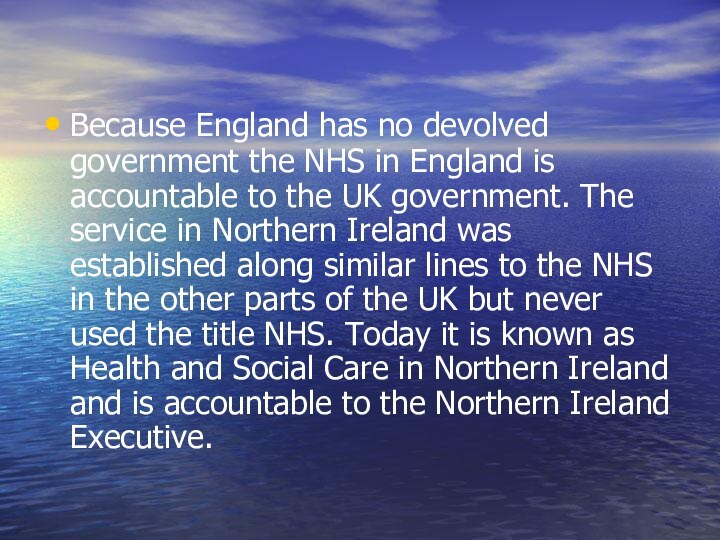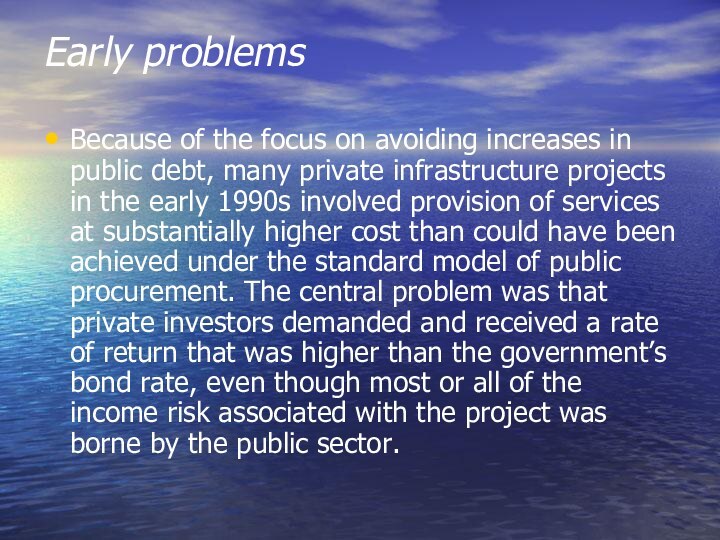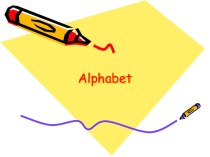- Главная
- Разное
- Бизнес и предпринимательство
- Образование
- Развлечения
- Государство
- Спорт
- Графика
- Культурология
- Еда и кулинария
- Лингвистика
- Религиоведение
- Черчение
- Физкультура
- ИЗО
- Психология
- Социология
- Английский язык
- Астрономия
- Алгебра
- Биология
- География
- Геометрия
- Детские презентации
- Информатика
- История
- Литература
- Маркетинг
- Математика
- Медицина
- Менеджмент
- Музыка
- МХК
- Немецкий язык
- ОБЖ
- Обществознание
- Окружающий мир
- Педагогика
- Русский язык
- Технология
- Физика
- Философия
- Химия
- Шаблоны, картинки для презентаций
- Экология
- Экономика
- Юриспруденция
Что такое findslide.org?
FindSlide.org - это сайт презентаций, докладов, шаблонов в формате PowerPoint.
Обратная связь
Email: Нажмите что бы посмотреть
Презентация на тему The National Health Service (NHS)
Содержание
- 2. The National Health Service (NHS) is the
- 3. Because England has no devolved government the
- 4. One aspect of patient care beyond the
- 5. NHS in England
- 6. While the NHS in England is funded
- 7. Public-private partnership (PPP)
- 8. Public-private partnership (PPP) describes a government service
- 9. A typical PPP example would be a
- 10. Early problems Because of the focus on
- 11. One response to these negative findings was
- 12. Although the general view that governments should
- 13. Is the System of Social Welfare Fair?
- 14. What types of benefits are available to
- 15. The average size of pension in Russia
- 16. What benefits are the citizens of Russia
- 17. Скачать презентацию
- 18. Похожие презентации
The National Health Service (NHS) is the name commonly used to refer to the publicly-funded health care service in the United Kingdom excluding Northern Ireland. In England the name National Health Service is used without further

















Слайд 3 Because England has no devolved government the NHS
in England is accountable to the UK government. The
service in Northern Ireland was established along similar lines to the NHS in the other parts of the UK but never used the title NHS. Today it is known as Health and Social Care in Northern Ireland and is accountable to the Northern Ireland Executive.Слайд 4 One aspect of patient care beyond the hospital's
direct control has been bed-blockers which refers to patients
who have been declared fit for discharge but for some reason or other they are not able to return to their normal home. Often they are awaiting placement in some nursing home or other form of residential care. This strains hospital resources, through both increased costs and longer waiting times for other patients. Fines for social services departments did succeed in reducing bed-blocking, but the numbers are creeping up again.Слайд 6 While the NHS in England is funded centrally
by the government, care is provided by more than
400 independent regional healthcare organizations known as Trusts. The Trusts are responsible for different services in various regions: acute Trusts, ambulance Trusts, mental health Trusts, and primary care Trusts.Слайд 8 Public-private partnership (PPP) describes a government service or
private business venture which is funded and operated through
a partnership of government and one or more private sector companies. These schemes are sometimes referred to as PPP, P3 or P3.Слайд 9 A typical PPP example would be a hospital
building financed and constructed by a private developer and
then leased to the hospital authority. The private developer then acts as landlord, providing housekeeping and other non medical services while the hospital itself provides medical services.
Слайд 10
Early problems
Because of the focus on avoiding increases
in public debt, many private infrastructure projects in the
early 1990s involved provision of services at substantially higher cost than could have been achieved under the standard model of public procurement. The central problem was that private investors demanded and received a rate of return that was higher than the government’s bond rate, even though most or all of the income risk associated with the project was borne by the public sector.Слайд 11 One response to these negative findings was the
development of formal procedures for the assessment of PPPs
in which the central focus was on "value for money" rather than reductions in debt. The underlying framework was one in which value for money was achieved by an appropriate allocation of risk. These assessment procedures were incorporated in the private finance initiative and its Australian counterparts from the late 1990s onwards.Слайд 12 Although the general view that governments should seek
"value for money" has been widely accepted, there have
been continuing disputes over whether the guidelines designed to achieve these goals are appropriate, and whether they have been correctly applied in particular cases. Much of the discussion has been based on debates over the UK private finance initiative.Слайд 14 What types of benefits are available to different
categories of people?
Retirement pension
Widow's pension
Maternity pay
Child benefit
Unemployment benefit
Family credit
Invalidity
pensionMobility allowance
Income support
Housing benefit scheme
Слайд 16
What benefits are the citizens of Russia have?
Women
have a right to a pension at the age
of 55 and men at 60.Women who leave work to have a baby have a right to ask for a maternity allowance from the government.
There are allowances paid to elderly people. Retired people can get a salary or a wage and still receive their pension in full.
A wide range of other payments exists. For example, a child allowance is a small monthly payment for each child, usually paid to mothers.
People who do not work have the right to a monthly payment, too. Scholarships are paid to young people, college and higher school students, if they do not pay fees (money) for their education.
People who are disabled can receive invalidity pension.
Widows can get payments for their husbands who died.





























